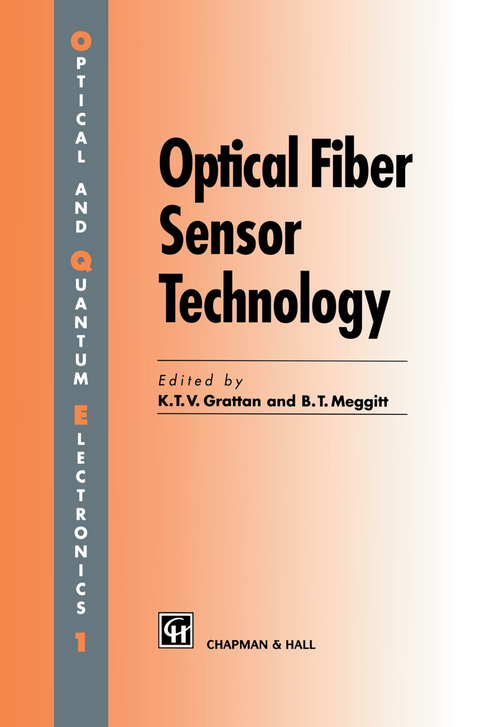
Optical Fiber Sensor Technology
Springer (Verlag)
978-94-010-4530-8 (ISBN)
Extensively illustrated and carefully referenced, this volume will prove an invaluable source for researchers, engineers and advanced students from the fields of optoelectronics/optics and/or measurement and sensors.
1 Overview of fiber sensor developments.- 1.1 Introduction.- 1.2 Current state of the art.- 1.3 Future developments.- 1.4 Summary.- References.- 2. Foundations of optical fiber technology.- 2.1 Introduction.- 2.2 Optical guidance.- 2.3 Fiber dispersion.- 2.4 Commercially available optical fibers.- 2.5 Fiber fabrication and strength.- 2.6 Fiber attenuation.- 2.7 Modal noise.- 2.8 Power handling.- 2.9 Fiber handling.- 2.10 Polarization behavior in optical fibers.- 2.11 Fiber components.- References.- Further Reading.- 3. Sources for optical fiber sensors.- 3.1 Introduction.- 3.2 Basics of radiation sources.- 3.3 Incoherent sources.- 3.4 Coherent sources.- 3.5 Choice of photon detectors.- 3.6 Summary of laser sources.- 3.7 Conclusions.- References.- 4 Optical detectors and receivers.- 4.1 Introduction.- 4.2 Photothermal detectors.- 4.3 Photoemissive devices.- 4.4 Photoconductive detectors.- 4.5 Photodiodes.- 4.6 Receivers.- 4.7 Noise in photodiode receivers.- 4.8 Conclusions.- References.- Further reading.- 5. Multimode optical fiber sensors.- 5.1 Introduction.- 5.2 Formal systems approach.- 5.3 Source and fiber effects.- 5.4 Some important modulation mechanisms.- 5.5 Signal processing and system architecture.- 5.6 Conclusions.- References.- 6 Multimode optical fiber chemical sensors.- 6.1 Introduction.- 6.2 Perceived advantages and disadvantages for chemical sensing.- 6.3 Underlying principles of fiber optic chemical sensors.- 6.4 Classifying fiber optic sensors for chemical sensing.- 6.5 Description of some illustrative sensors.- 6.6 Conclusions.- References.- 7 Single mode optical fiber sensors.- 7.1 Introduction.- 7.2 Interferometer configurations.- 7.3 Transfer functions of interferometers.- 7.4 Signal processing techniques.- 7.5 Fiber interactions.- 7.6 Applications.- References.- 8 Optical fiber modulation techniques for single mode fiber sensors.- 8.1 Introduction.- 8.2 Optical fiber phase modulators.- 8.3 Optical fiber frequency shifters.- 8.4 In-line fiber intensity modulators.- References.- 9. Fiber optic white-light interferometric sensors.- 9.1 Introduction.- 9.2 Spectral domain processing.- 9.3 Phase domain processing.- 9.4 Spatial domain processing.- 9.5 Spatial to temporal fringe generation.- 9.6 Quasi-distributed sensor systems: multiplexing.- 9.7 Bragg-grating devices.- References.- 10 Nonlinear effects in optical fibers.- 10.1 Introduction.- 10.2 Parametric effects.- 10.3 Inelastic scattering.- 10.4 Conclusions.- References.- 11 Distributed fiber optic sensors.- 11.1 Introduction.- 11.2 Classification of distributed optical fiber sensors.- 11.3 Principles of operation.- 11.4 Performance of distributed sensors and engineering aspects.- 11.5 Applications.- 11.6 Examples of practical implementations of distributed sensors.- 11.7 Safety of distributed sensors.- 11.8 Future prospects.- References.- 12 Schemes for referencing of intensity-modulated optical sensor systems.- 12.1 Introduction.- 12.2 Important design considerations.- 12.3 Referencing mechanisms.- 12.4 Spatial referencing.- 12.5 Temporal referencing.- 12.6 Dual wavelength referencing.- 12.7 Comparative assessment.- 12.8 Summary.- References.- 13A Hybrid optical fiber sensors.- 13A.1 Introduction.- 13A.2 Sensor excitation.- 13A.3 Sensor classification.- 13A.4 Hybrid actuators.- 13A.5 Hybrid sensor multiplexing.- 13A.6 Conclusions.- References.- 13B Optical fiber current measurement.- 13B.1 Introduction.- 13B.2 Basic principle.- 13B.3 Design features.- 13B.4 Evaluation of experimental devices.- 13B.5 Device analysis.- 13B.6 Conclusions.- References.- 13C Fiber optic techniques for temperature measurement.- 13C.1 Introduction.- 13C.2 Sensor devices.- 13C.3 Conclusions.- References.- 14 Advanced external fiber optic sensors.- 14.1 Laser Doppler anemometry.- 14.2 Transit time (two-spot) anemometers (TTA).- 14.3 Noncontact vibrometers (NCV).- 14.4 Holography and TV holography.- 14.5 Accelerometers and geophones.- 14.6 Optical displacement.- 14.7 Conclusions.- References.
| Reihe/Serie | Optoelectronics, Imaging and Sensing ; 1 |
|---|---|
| Zusatzinfo | XX, 499 p. |
| Verlagsort | Dordrecht |
| Sprache | englisch |
| Maße | 155 x 235 mm |
| Themenwelt | Naturwissenschaften ► Physik / Astronomie ► Optik |
| Technik ► Elektrotechnik / Energietechnik | |
| Technik ► Maschinenbau | |
| ISBN-10 | 94-010-4530-5 / 9401045305 |
| ISBN-13 | 978-94-010-4530-8 / 9789401045308 |
| Zustand | Neuware |
| Haben Sie eine Frage zum Produkt? |
aus dem Bereich


